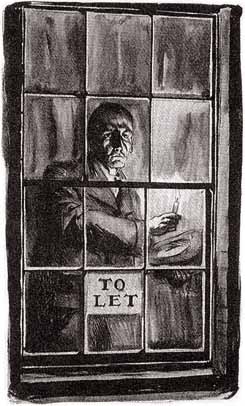A Scion Society of The Baker Street Irregulars

The 17 Steps: The Red Circle
Seventeen thoughts for further ponderance of the case at hand – The Red Circle (REDC)

WHAT’S SHERLOCK GOT AGAINST MRS. WARREN?
We begin this case with Holmes saying, “Well, Mrs. Warren, I cannot see that you have any particular cause for uneasiness, nor do I understand why I, whose time is of some value, should interfere in the matter.”
He then proceeds to ignore her. Then Mrs. Warren finally convinces him just to *listen* to her case. Up until this point, Holmes hasn’t heard anything but the fact that Mrs. Warren’s lodger doesn’t leave his rooms, and he probably heard that from Mrs. Hudson. Isn’t Holmes violating everything he ever preached to Watson early in their partnership? Theorizing in advance of the facts. Ignoring commonplaces, just because they’re commonplace. Is Mrs. Warren an especially irritating person whom he’s endured before? Is the scrapbook business a lot more fascinating than one would think? Or has Holmes become addicted to rubber cement fumes?
GIVING MRS. WARREN THE HOLMES HYPNO-STARE
“Holmes leaned forward and laid his long, thin fingers upon the woman’s shoulder. He had an almost hypnotic power of soothing when he wished. The scared look faded from her eyes, and her agitated features smoothed into their usual commonplace.”
Sounds good, but let’s break this down. Holmes leans in close enough to Mrs. Warren to put his fingers on her shoulder. He doesn’t seem to say anything at all, as would seem natural in such a lean-in moment of comfort. So what’s he doing? If he’s looking her straight in the eye while touching her at arm’s length, wouldn’t that be a little creepy? He’s not patting her — it’s all fingers and shoulder. Is he trying to give her a Vulcan nerve pinch?
URBAN SECURITY, VICTORIAN STYLE
While those of us who live near small towns must constantly endure tales of how everyone used to leave their doors unlocked in the good old days, we find a quite different version of things in Mrs. Warren’s neighborhood. Her new lodger asks her not to bar the door before he comes in on that first night. How many households in London of that period actually laid a bar across their door before turning in? Was it more common that locks in the less affluent districts?
HOLMES GOES FOR THE EASY SHOT
This case has to contain the surmise that puts the “duh” in “deduction” as Holmes looks at the two matches and cigarette stub brought by Mrs. Warren and says: “The matches have, of course, been used to light cigarettes. That is obvious from the shortness of the burnt end. Half the match is consumed in lighting a pipe or cigar.”
Okay, pipe or cigar smokers, is that necessarily true?
And why did Mrs. Warren only bring *one* cigarette butt and two matches? Nobody smokes just one cigarette, uses two matches to light it, and neither of the matches shows signs of being burned down during a failed lighting attempt. Any ideas?
LIFE IN THE AGONY COLUMN OF THE DAILY GAZETTE
As if the untold tales weren’t enough, Holmes teases us with partial ads from the personal column:
“Lady with a black boa at Prince’s Skating Club ….”
“Surely Jimmy will not break his mother’s heart ….”
“If the lady who fainted in the Brixton bus ….”
“Every day my heart longs ….”
What might we deduce from such samples? Would a lady skating with a black boa have questionable morals, or is she just another typist in a Duchess of Devonshire hat? Is Jimmy destined for a life of crime? What happened to the woman who fainted on the bus, and why would anyone want to contact her? And as for that longing heart … well, there are a few too many longing hearts in the world for any deductions from that one … aren’t there?
THE EASIEST CASE HOLMES EVER HAD
If the “lighting cigarettes” deduction wasn’t simple enough, the code Holmes gets to break in this case is surely the limit:
“The path is clearing. If I find chance signal message remember code agreed–one A, two B, and so on. You will hear soon. G.”
And that’s from the newspaper. How simple did G. think his wife was that he had to reminder her of the world’s easiest code key? If she’s that dense, why didn’t he also write, “I’ll wave a candle back and forth in the window once for each count”?
WARREN — THE HUMAN PUNCH CLOCK?
And now the discussion leader’s foolish question of the week. We are told that “Mr. Warren is a timekeeper at Morton and Waylight’s, in Tottenham Court Road.” What or who was he timing?
RECOGNITION COMES SLOWLY SOMETIMES
As if everyone else in this case hasn’t already seemed dim enough, the thugs that kidnap Mr. Warren take a full hour to realize they’ve gotten the wrong man. Did they ever pull the coat off of him? How did they know they’d gotten the wrong man, and why didn’t they realize that before they put the coat on him? Did they take him to their chief in that hour, an event Warren was to insensible to notice?
HE ALWAYS RETURNS TO HIS ROOTS
“At half-past twelve we found ourselves upon the steps of Mrs. Warren’s house–a high, thin, yellow-brick edifice in Great Orme Street, a narrow thoroughfare at the northeast side of the British Museum.”
Does Holmes wind up in his old neighborhood around the British Museum an uncommon amount of times? Or was the Museum the sort of central location one would expect to wind up at time and again?
SOMETHING SPECIAL ABOUT THE LODGER
Holmes admits that “What I did not foresee is that we should find a woman, and no ordinary woman, Watson.”
So what is it about the lady that makes her “not ordinary” to Holmes? Is he actually commenting upon her good looks?
THE SMARTEST MAN AT SCOTLAND YARD RETURNS
We originally meet Inspector Gregson at the same time as Inspector Lestrade in the very first Holmes tale. Yet Gregson virtually disappears from the stories after that, with Lestrade gaining prominence. Even in this case, one of Gregson’s few appearances, the encounter comes entirely by accident.
Both each man seems to admire the other, so it doesn’t seem to be a matter of personal friction. So why don’t we see more of Gregson in the Canon?
THERE’S “KNOWING” AND THEN THERE’S “KNOWING”
Detective Leverton says, of Giorgiano, “We know he is at the bottom of fifty murders, and yet we have nothing positive we can take him on.”
So how does one know that someone is behind fifty murders (and that’s just in America), yet not have proof of any sort to arrest him? They had to hear that Giorgiano did the killings from somebody, didn’t they? Was the burden of proof harder to make back then, or easier? Or was Pinkerton’s involved because local New York law enforcement was too corrupt and wouldn’t arrest him?
LEVERTON — HOT SHOT DETECTIVE OR SOMETHING ELSE?
An interesting moment occurs on the stairs as the forces of justice move in on Giorgiano: “The Pinkerton man had tried to push past him, but Gregson had firmly elbowed him back.”
What was Leverton’s hurry? Was he seeking credit for the arrest? Did he have a personal grudge against Giorgiano? Or was there some more sinister purpose behind the hero of a supposed mystery involving caves where no caves supposedly exist?
THE POLITICS OF CRIME
“My poor Gennaro, in his wild and fiery days, when all the world seemed against him and his mind was driven half mad by the injustices of life, had joined a Neapolitan society, the Red Circle, which was allied to the old Carbonari.”
How would an alliance between the Red Circle and the Carbonari serve either group? Wouldn’t one criminal society be looking to keep the other out of its business? While we see the Red Circle moving on to America, did the Carbonari ever make such a move?
FIXING THE DRAWING
“There was a drawing of lots as to who should carry out the deed. Gennaro saw our enemy’s cruel face smiling at him as he dipped his hand in the bag. No doubt it had been prearranged in some fashion, for it was the fatal disc with the Red Circle upon it, the mandate for murder, which lay upon his palm.”
Okay, I can understand how one fixes a drawing so one can pull the winner out for one’s self. But how do you fix it so a specific someone else pulls the winner?
THE CURIOUS AGENDA OF GENNARO LUCCA
“Finally Gennaro told me, through the paper, that he would signal to me from a certain window, but when the signals came they were nothing but warnings, which were suddenly interrupted.”
What had Gennaro hoped to tell his wife through candle signals that he couldn’t tell her via the newspaper? And what good are “Warning! Warning! Warning! Danger! Danger! Danger!” messages, anyway? Once he had killed Giorgiano, why didn’t Gennaro head straight for his wife, anyway? Had the rest of the Red Circle dragged him off? Or was he running the gang now?
LOOKING BACK AT HOLMES’S PRIORITIES
“By the way, it is not eight o’clock, and a Wagner night at Covent Garden! If we hurry, we might be in time for the second act.”
It’s interesting to note that Holmes is not so focussed on this case that he can’t carry concert schedules in his head. Is this a sign he’s losing interest in detection, or has his concert-going always had a priority?
The Seventeen Steps originally appeared on the Hounds of the Internet e-list from September 2000 to October 2001 and later on the Sherlock Peoria blog.
 Brad Keefauver, the 41st Garrideb, is the author of The Elementary Methods of Sherlock Holmes, Sherlock and the Ladies, and The Armchair Baskerville Tour. Former publisher of The Holmes & Watson Report, The Dangling Prussian, and a whole lot of obscure, collectable little things on our boy Sherlock. Keefauver is a member of the Baker Street Irregulars and the Adventuresses of Sherlock Holmes.
Brad Keefauver, the 41st Garrideb, is the author of The Elementary Methods of Sherlock Holmes, Sherlock and the Ladies, and The Armchair Baskerville Tour. Former publisher of The Holmes & Watson Report, The Dangling Prussian, and a whole lot of obscure, collectable little things on our boy Sherlock. Keefauver is a member of the Baker Street Irregulars and the Adventuresses of Sherlock Holmes.

Sorry, comments are closed for this post.